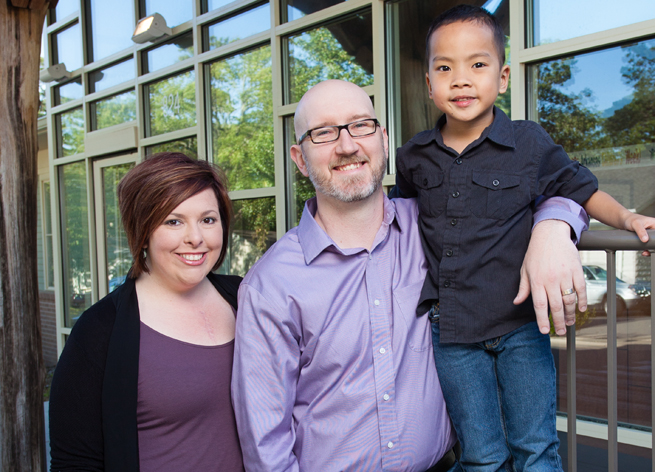With Cardiac Challenges, Myers Family Shows Heart
At six years old, I had my first open heart surgery to replace a faulty aortic valve. At nine we repeated the procedure, and at 16 we did it again. It is because of my cardiac history that my husband, Ken, and I decided to expand our family through adoption, and it is the reason we chose to seek out a child with cardiac challenges of his own.
That said, this is not an adoption story. It is not a story about a formerly special needs child who grew up and started a family. This is a story about joy. A story about love, and hope, and listening to your gut. This is a story about getting help when you need it and learning to find your way. This is our story.
Beckett came home from Vietnam two weeks shy of his first birthday. He was tiny and perfect and full of personality. Though we were slated to be in the country for close to 20 days, we received special permission to come home around the 10-day mark. We were expecting immediate heart surgery, and arranged a pediatrician appointment for the morning after we landed in Little Rock.
Jet lagged and overwhelmed, we made our way to the doctor only to find out that he had a raging ear infection, but very little else. We could hardly believe our ears. After months of waiting for this child, worrying over his cardiac status, we were greeted with the news that he had a significant murmur, but not the issues that he had been “diagnosed” with in Vietnam. A cardiologist confirmed a few months later that no surgery would be needed. Beckett was pronounced a healthy baby with a very mild heart condition that likely wouldn’t even require lifelong monitoring. That was a very good day.
Six months after we arrived home, we had a follow-up appointment with our adoption social worker. Beckett was nearly 18 months old at the time and she asked if he was talking. He was not. We had assumed that his silence was due to a change from Vietnamese to English, and our doctors had assured us that all was well. For first time parents, doctors are like gods. Their word is infallible; after all, they have years of data to draw from, while you only have one child. But I knew he was quiet. I had noticed that one of his hands was always in a fist. We had been prepared for one set of challenges, but it wasn’t this set.
So began our immersion in speech therapy, physical therapy and occupational therapy. We soon learned a whole new vocabulary: Dysarthria. Aphasia. Autism. Deafness. Auditory Processing Disorder. Brachial Plexus Injury. Cerebral Palsy. Pervasive Developmental Disorder Not Otherwise Specified. Apraxia. Dysphasia. Each one sounded scarier than the last. I quit working so that I could take him to 12 hours of appointments every week. There were no answers and very little progress, but then we found hope.
Referred by a friend, we contacted The Allen School, a local preschool and day-habilitation center for children with developmental disabilities. On Beckett’s first day there, his supervising teacher called and asked me about his hand. She saw what everyone else had dismissed. That moment proved to be the key to unlocking his puzzle. Six months and countless doctor visits later, we were on a path to help his hand. Because of The Allen School’s therapy team, it went from 10% function to 90% in less than a year. His expressive vocabulary increased from under 10 words to 25. He was three years old.
Officially diagnosed with a Brachial Plexus Birth Injury and Apraxia of Speech (a motor planning disorder that makes word formulation difficult), he will likely require continued therapies into adulthood, but today my kindergartener is flourishing. He attends elementary school in a regular classroom. He reads. He writes. He aces spelling tests with three syllable words. He tells jokes. He plays with friends. He does all of the things that neuro-typical children do, though it takes a little bit more effort for him to do so.
Much has changed in the past three years. Then, the future was frightening. Now I am excited to see what it holds. If the last three years are any indication, my son has great things ahead.
Read more about Beckett’s path to diagnosis, local special needs resources or the adoption process, at Jessica’s semi-neglected blog, www.TheBexFiles.com.



